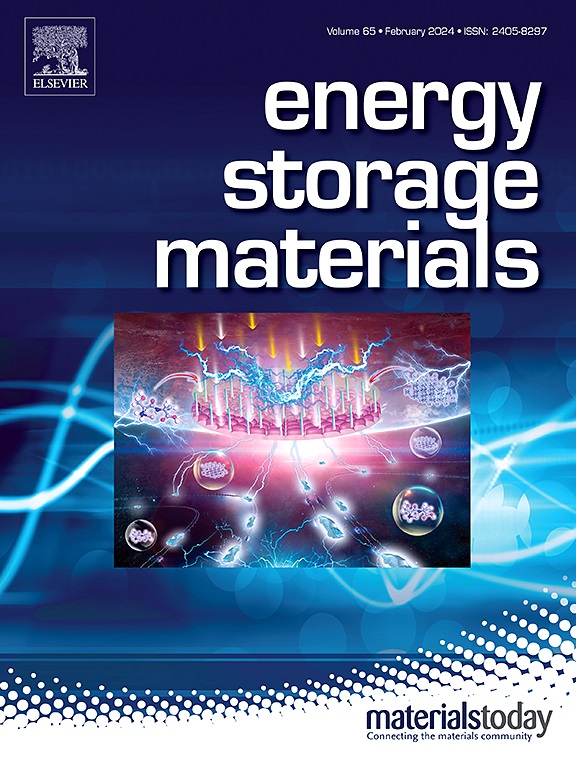通过结构-界面协同打破锌离子电容器厚电极的动力学-负载困境:具有双位点吸附能量调制的分层纳米结构
IF 18.9
1区 材料科学
Q1 CHEMISTRY, PHYSICAL
引用次数: 0
摘要
锌离子电容器的厚电极受到快速反应动力学和高质量负载之间的性能矛盾的限制。突破这一瓶颈的关键是弄清电极内部的多物理场耦合机制,揭示离子跨尺度迁移和界面吸附/脱附的协同储能规律。本研究提出了一种“结构-界面”协同优化策略:基于天然木质骨架,通过树脂构建三维互联多级孔隙网络,实现孔径与水合锌离子的精确匹配,并引入N/O双原子掺杂调节表面电荷分布。WPNK2电极表现出令人满意的5.8 mAh cm-2容量,并在200 mA cm-2时保持1.9 mAh cm-2。同时,当负载增加到82.75 mg cm-2时,它提供了10.9 mAh cm-2的惊人容量。结合原位光谱、DFT和电化学动力学分析,揭示了厚电极中离子传递和界面吸附的多级储能机理。本工作为解决厚电极材料“动力学-载荷”权衡问题提供了“结构设计-界面工程-机理分析”的全链条研究范式,将促进高能量密度zic器件的发展。本文章由计算机程序翻译,如有差异,请以英文原文为准。


Breaking the kinetics-load dilemma in zinc-ion capacitor thick electrodes via structure-interface synergy: Hierarchical nanoarchitectures with dual-site adsorption energetics modulation
The thick electrode of zinc ion capacitors (ZICs) is limited by the performance contradiction between fast reaction kinetics and high-quality load. The key to break through this bottleneck is to clarify the multi-physical field coupling mechanism inside the electrode and reveal the synergistic energy storage law of ion cross-scale transport and interface adsorption/desorption. In this study, a “structure-interface” collaborative optimization strategy was proposed: based on the natural wood framework, a three-dimensional interconnected multi-level pore network was constructed by resin to realize the precise matching of pore size and hydrated zinc ions, and N/O diatomic doping was introduced to regulate the surface charge distribution. The WPNK2 electrode exhibits a satisfactory capacity of 5.8 mAh cm–2 and maintains 1.9 mAh cm–2 at 200 mA cm–2. At the same time, it provides a surprising capacity of 10.9 mAh cm–2 when the load is increased to 82.75 mg cm–2. Combined with in-situ spectroscopy, DFT, and electrochemical kinetic analysis, the multi-level energy storage mechanism of ion transport and interface adsorption in thick electrodes was revealed. This work provides a full-chain research paradigm of “structural design-interface engineering-mechanism analysis” for solving the “kinetics-load” trade-off problem of thick electrode materials, which will promote the development of high energy density ZICs devices.
求助全文
通过发布文献求助,成功后即可免费获取论文全文。
去求助
来源期刊

Energy Storage Materials
Materials Science-General Materials Science
CiteScore
33.00
自引率
5.90%
发文量
652
审稿时长
27 days
期刊介绍:
Energy Storage Materials is a global interdisciplinary journal dedicated to sharing scientific and technological advancements in materials and devices for advanced energy storage and related energy conversion, such as in metal-O2 batteries. The journal features comprehensive research articles, including full papers and short communications, as well as authoritative feature articles and reviews by leading experts in the field.
Energy Storage Materials covers a wide range of topics, including the synthesis, fabrication, structure, properties, performance, and technological applications of energy storage materials. Additionally, the journal explores strategies, policies, and developments in the field of energy storage materials and devices for sustainable energy.
Published papers are selected based on their scientific and technological significance, their ability to provide valuable new knowledge, and their relevance to the international research community.
 求助内容:
求助内容: 应助结果提醒方式:
应助结果提醒方式:


